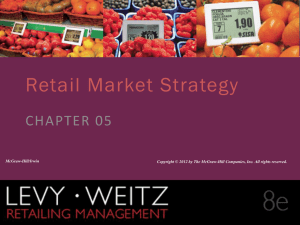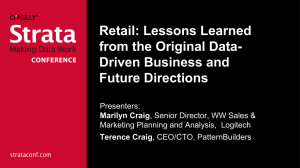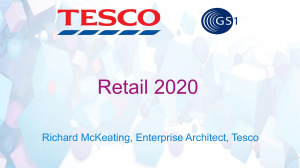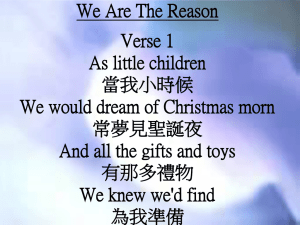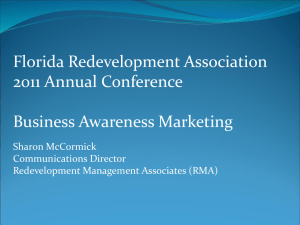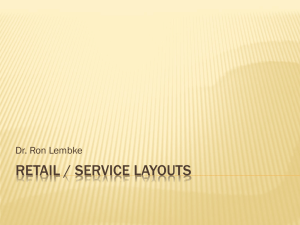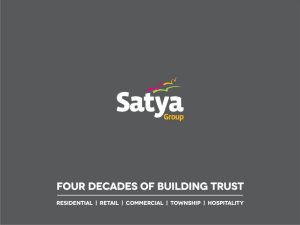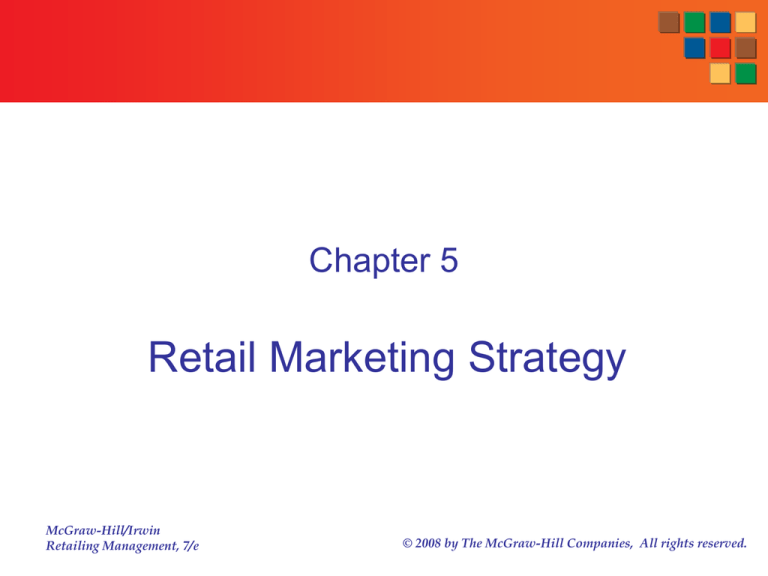
Chapter 5
Retail Marketing Strategy
McGraw-Hill/Irwin
Retailing Management, 7/e
© 2008 by The McGraw-Hill Companies, All rights reserved.
Retailing Strategy
Human Resource
Management
Chapter 9
Retail Locations
Chapters 7,8
Retail Market Strategy
Chapter 5
Financial Strategy
Chapter 6
Information and
Distribution
Systems
Chapter 10
Customer
Relationship
Management
Chapter 11
5-2
Questions
■ What is a retailing strategy?
■ How can a retailer build a sustainable
competitive advantage?
■ What steps do retailers go through to develop a
strategy?
■ What different strategic growth opportunities can
retailers pursue?
■ What retailers are best positioned to become
global retailers?
5-3
More attention to long-term strategic
planning than ever before
Due to the emergence of
■ New competitors
■ New formats
■ New technologies
■ Shifts in customer needs
5-4
Elements in Retail Strategy
■ Target Market
the market segment(s) toward which the retailer plans
to focus its resources and retail mix
■ Retail Format
the nature of the retailer’s operations—its retail mix
■ Sustainable Competitive Advantage
an advantage over the competition
5-5
© image100 Ltd
Analyzing McDonalds’ Retail Strategy
Retail offering (format)?
Bases for competitive
advantage?
The McGraw-Hill Companies, Inc./John Flournoy, photographer
Target market?
What Threats Might McDonald’s Face in the Future?
5-6
Examples of Retail Strategies
Steve & Barry’s
Chico’s
Curves
Magazine Luiza
Starbucks
What is the target market, retail offering, and
source of competitive advantage for each retailer?
5-7
Steven & Barry’s
■ Target Market
Value and quality conscious consumers for university
sportswear
■ Retail Format
stores are in middle-market malls
extreme low prices, quality private-label merchandise,
upscale surroundings (“Old Navy on steroids”)
■ Bases for Building Sustainable Competitive Advantage
No advertising
Aggressive incentives from mall owners
Creative approaches to working with vendors
5-8
Chico’s Strategy
■ Target Market
Woman 35 to 55 Who Want Comfortable, Casual,
But Stylish Apparel
■ Retail Format
Specialty Apparel Stores in Malls and Strip Centers
Selling Private Label, Coordinated Outfits
■ Bases for Building Sustainable Competitive Advantage
Unique Merchandise Sized 0,1,2,3
5-9
Target Market
Why Does a Retailer Need to Focus on
a Specific Target Market?
Why Not Sell to Everyone?
5-10
Target market and retail format:
Retail Market Opportunities for Women’s Apparel
5-11
■ If TARGET decides to focus on a limited set of
markets for women’s apparel, which should it
pursue?
■ What should be the retail strategy for that target
market?
5-12
Criteria For Selecting A Target Market
■ Attractiveness -- Large,
Growing, Little
Competition More
Profits
■ Consistent with Your
Competitive Advantages
Rim Light/PhotoLink/Getty Images
5-13
Opportunities for retailers to develop sustainable
competitive advantages
■
■
■
■
■
■
■
Customer Loyalty
Location
Human Resource Management
Distribution and Information Systems
Unique Merchandise
Vendor Relations
Customer Service
5-14
PhotoLink/Getty Images
Can A Retailer Develop a Sustainable
Competitive Advantage by:
■ Dropping the Price of Your
Merchandise?
■ Building a Store at the Best Location?
■ Deciding to Sell Some Hot
Merchandise?
■ Increasing Your Level of Advertising?
■ Attracting Better Sales Associates by
Paying Higher Wages?
■ Providing Better Customer Service?
5-15
Sources of Competitive Advantage
More Sustainable
Less Sustainable
■
■
■
■
■
■
■
■
■
■
■
■
■
Location
Customer Loyalty
Customer Service
Exclusive Merchandise
Low Cost Supply Chain
Management
■ Information Systems
■ Buying Power with Vendors
■ Committed Employees
Better Computers
More Employees
More Merchandise
Greater Assortments
Lower Prices
More Advertising
More Promotions
Cleaner Stores
5-16
Internal and External Bases for
Competitive Advantage
Vendors,
Suppliers
Retail Firm
•Low Cost
•Large Size
•Efficient
Distribution,
Operations
• Unique
Knowledge
• Loyal Employees
Customers
Sources of
Capital
5-17
Loyalty
What does loyalty mean?
Is It the same as liking a store?
…Going to the store frequently?
5-18
Customer Loyalty
■ More than simply liking one retailer over another
■ Customers will be reluctant to patronize
competitive retailers
■ Retailers build loyalty by:
Developing a strong brand for the store or store
brands
Developing clear and precise positioning strategies
Creating an emotional attachment with customers
through loyalty programs
5-19
Retail Branding
Stores use brand (store’s name and store brands –
private label brands) to build customer loyalty
Retail brand
■ Can create an emotional
tie with customers that
build their trust and loyalty
■ Facilitates store loyalty
because it stands for a
predictable level of quality
5-20
Loyalty Programs
■ Part of an overall Customer Relationship Management
(CRM) program
■ Purchase behaviors of members of loyalty programs
Are identified when they buy because they use some type of
loyalty card
Saved in Data Warehouse
• What they buy
• When they buy
• How much they buy
• How often they buy
• How much they spend
• What channel they use
■ Develop personalized marketing effort to them
5-21
Approaches for Building
Customer Loyalty
■
■
■
■
■
Unique Positioning
Location
Customer Service
Information About Customers (Database)
Unique Merchandise
5-22
Example of Positioning
5-23
Location
■ What are the three most important things in
retailing?
“location, location, location”
■ Location is a competitive advantage
A high density of Starbucks stores
• Creates a top-of-mind awareness
• makes it very difficult for a competitor to enter a
market and find a good locations
5-24
Human Resources
■ “Employees are key to build a sustainable
competitive advantage”
■ Strategies for Recruiting and Retaining Talented
Employees
■ Employee Branding
■ Develop positive organizational culture
5-25
Distribution and Info Systems
Flow of Information
Vendor
Distribution Center
Store
By decreasing costs here, the
is more money available to
invest in:
-Better services
-Increase in breadth and depth
-Decrease in prices
5-26
Rob Melnychuk/Getty Images
Unique Merchandise: Private Labels
Sears’ Kenmore -- appliances
Federated’s Inc. – fine apparel
Kmart’s Martha Stewart -- home
JCPenney’s Arizona -- jeans
Jules Frazier/Getty Images
5-27
Jacobs Stock Photography/Getty Images
Vendor Relationships
■ Low Cost - Efficiency Through Coordination
Electronic Data Interchange (EDI)
Collaborative Planning and Forecasting to
Reduce Inventory and Distribution Costs
■ Exclusive Sale of Desirable Brands
■ Special Treatment
Early Delivery of New Styles
Shipment of Scare Merchandise
5-28
High Quality Customer Service
■ Difficult to Achieve
People Are Not Machines -- Inconsistent
Retail Sales Associates At Bottom of Labor Pool
■ Goes Beyond Hiring Good People at High
Wages and Training Them -- Organizational
Culture
5-29
Critical Tradeoff In Developing
Strategic Advantage
Focus Leads to Developing
A Competitive Advantage
But
Focus Reduces Flexibility
■ Low Cost, Consistent Image, Vendor
Relationships Reduces Flexibility
■ Similar to Dating and Marriage – Commitment
to a Relationship (Vendor) Reduces Flexibility
5-30
Growth Strategies
■
■
■
■
Market Penetration
Market Expansion
Retail Format Development
Diversification
Related vs. Unrelated
Ryan McVay/Getty Images
5-31
Growth Opportunities
5-32
Market Penetration
■ Attract customers from target market – Walgreens “on
every corner”
■ Get current customer to visit store more often or buy on
each visit
Cross Selling – sales associates in one department sell
complimentary merchandise from other departments
Example: Manicurist sells services plus hand lotion or nail polish
Example: Salesperson sells leaf blower directs customer to electrical
department to purchase a 100 foot extension cord.
5-33
Market Expansion
■ Market expansion growth opportunity involves
using the existing retail format in new market
segments
Dunkin’ Donuts – new stores (and at gas stations)
outside northeastern
Abercrombie & Fitch (for college students) opens
lower-priced chain Hollister Co. for highschoolers
5-34
Retail Format Development
■ Develops a new retail format with a different
retail mix for the same target market
■ Multi-channel retailing
■ UK based TESCO:
Tesco Express: small stores located close to where
customers live and work
Tesco Metro: bring convenience to city center location
by specializing in ready-to-eat meals
Tesco Superstores: traditional stores
Tesco Extra: one-stop destination with the widest
range of food and non-food products
5-35
Diversification
■ Introduces a new retail format toward a market
segment that is not currently served by the
retailer
■ Related diversification
■ Unrelated diversification
■ Vertical integration into wholesaling or
manufacturing
5-36
Global Growth Opportunities
Who Is Successful and Who Isn’t?
■ Specialty store retailers with
strong brand and unique
merchandise?
McDonald’s
Starbucks
Zara
H & M
■ Discount and food retailers
with deep assortments and low
prices?
Wal-Mart
Carrefour
Royal Ahold
Metro AG
5-37
Steve Cole/Getty Images
IKEA
■ Operates 254 stores in 35
countries
■ Unique, well-designed,
functional furniture at low
prices for consumers who
have sophisticated tastes
but have no intention to
spend lots of money
■ “You do our part. We do
our part. Together, we
save money.”
5-38
Why Do Category Killers and Supercenters
Succeed Globally?
■ Developed operating expenses
■ Scale economies for buying
merchandise globally
■ Unique systems and standardization
formats that facilitate control over
multiple stores
■ Understand that consumers are willing
to forego service for lower prices
Ryan McVay/Getty Images
5-39
Key to Success in Global Retailing
■ Globally sustainable competitive
advantage
Low cost, efficient operations - WalMart, Carrefour
Strong private label brands:
Starbucks, KFC
Fashion Reputation - The Gap, Zara,
H&M
Category dominance – Best Buy,
IKEA, Toys R Us
■ Adaptability
■ Global Culture
■ Financial Resources
5-40
Evaluating Global Growth Opportunities
Rankings are based on
weighted score using
growth (55%),
risk (25%), and
market size (20%)
5-41
5-42
Evaluating Global Growth Opportunities
Consider challenges and how to overcome them
■ China
Increasing operating costs
Lack of managerial talent
Underdeveloped and
inefficient supply chain
■ India
Prefers small family-owned
stores
Restricts foreign investment
5-43
International Market
Entry Strategies
Direct Investment
Joint Ventures
Strategic Alliances
Profit and Risk
Franchising
5-44
Stages in the Strategic
Retail Planning Process
1. Define the business mission
2. Conduct a situation audit:
Market attractiveness analysis
Competitor analysis
Self-analysis
3. Identify strategic opportunities
4. Evaluate strategic alternatives
5. Establish specific objectives and allocate resources
6. Develop a retail mix to implement strategy
7. Evaluate performance and make adjustments
5-45
Elements in a Situation Audit
MARKET
FACTORS
Size
Growth
Seasonality
Business cycles
COMPETITIVE
FACTORS
ENVIRONMENTAL
FACTORS
ANALYSIS OF
STRENGTHS &
WEAKNESSES
Barriers to entry
Bargaining power of
vendors
Competitive rivalry
Threat of superior
new formats
Technology
Economic
Regulatory
Social
Management
capabilities
Financial resources
Locations
Operations
Merchandise
Store Management
Customer loyalty
5-46
Market Factors
■ Market size – large markets attractive to large
retail firms
■ Growth – typically more attractive than mature or
declining
■ Seasonality – can be an issue as resources are
necessary during peak season only
■ Business cycles – retail markets can be affected
by economic conditions – military base towns
5-47
Competitive Factors
■ Barriers to entry
Scale economies of big box retailers
Service and unique, high-end products of small retailers
■ Bargaining power of vendors
Markets are less attractive when only a few vendors control the
merchandise sold in it
■ Competitive rivalry
Defines the frequency and intensity of reactions to actions
undertaken by competitors
Conditions leading to intense rivalry: a large number of same
size retailers, slow growth, high fixed costs, a lack of perceived
differences between competing retailers
5-48
Questions for
Analyzing the Environment
• New developments or changes -technologies, regulations, social
factors, economic conditions
• Likelihood changes will occur
• Key factors determining change
• Impact of change on retail market
firm, competitors
5-49
Strengths and Weaknesses Analysis
Management Capability:
Capabilities and experience of top management
Depth of Management--capabilities of middle management
Management’s commitment to firm
Financial Resources:
Cash flow from existing business
Ability to raise debt or equity financing
Operations:
Store Management Capabilities
Overhead cost structure
Quality of operating systems
Distribution capabilities
Management information systems
Loss prevention systems
Inventory control system
Management capabilities
Quality of sales associates
Commitment of sales associates to firm
Locations
Merchandising Capabilities:
Knowledge and skills of buyers
Relationships with vendors
Capabilities in developing private
capabilities
Customers
Loyalty of customers
5-50
Performing a Self-Analysis
■ At what is our company good?
■ In which of these areas is our company better
than our competitors?
■ In which of theses areas does out company’s
unique capabilities provide a sustainable
advantage or a basis for developing one?
5-51
Stockbyte/Punchstock Images
Illustration of the
Strategic Retail Planning Process
Kelly Bradford – Owner of Gifts To Go
Two Store Chain in Chicago
Target Market – Upper Income Men and Women
Looking for Gifts between $50 and $500
Strong Customer Loyalty Based on Knowing What
Customers Want, Providing Good Customer Service
Low Turnover Among Associates
5-52
Mission Statement for Gifts To Go
“The mission of Gifts to Go is to be the leading
retailers of higher-priced gifts in the Chicago and
provide a stable income of $100,000 per year for
the owner.”
■ Define growth opportunities will and won’t
consider
■ Indicates objective of company
5-53
Situation Analysis of Gifts to Go
■ Market Factors
Chicago is an attractive market. (+)
Relatively expensive gifts are not affected much by
the economy. (+)
Gifts are highly seasonal. (-)
■ Competitive Factors
Many in area. Primary department stores, craft
galleries, catalogs, and Internet retailers (-)
Lack of large suppliers, customer (+)
Opportunities for differentiation (+)
Limited competitive rivalry. (+)
5-54
Situation Analysis of Gifts to Go
■ Environmental Factors
Potential Threat - Development of electronic channel by
traditional bricks and mortar retailers (-)
■ Strengths and Weaknesses
Management Capability – Limited
Financial Resources – Good
Operations – Poor
Merchandise Capabilities – Good
Store Management Capabilities – Excellent
Locations – Excellent
Customer Loyalty – Good
Customer Database - Good
5-55
Growth Opportunities for Gifts to Go
■ Market Penetration
Increase size of present stores
Open additional gifts stores in
Chicago area
■ Market Expansion
Open gift stores outside Chicago
area
Sell lower priced gifts in present
stores
Ryan McVay/Getty Images
5-56
Growth Opportunities for Gifts to Go
■ Retail Format Development
Sell non-gift merchandise to same customers in
present or new stores
Sell similar gifts to same customers through an
electronic channel
■ Diversification
Manufacture craft gifts
Open an apparel store targeting teenagers
Open a category killer store selling a broader
assortment of gifts
5-57
Evaluating Growth Opportunities for
Gifts to Go
Market Attractiveness
■ Market Penetration
Increase size of present stores (low)
Open additional gifts stores in Chicago area (medium)
■ Market Expansion
Open gift stores outside Chicago area – new geographic
segment (medium)
Sell lower priced gifts in present stores – new benefit segment
(medium)
5-58
Evaluating Growth Opportunities for
Gifts to Go (continued)
Market Attractiveness
■ Retail Format Development
Sell non-gift merchandise to same customers in present or new
stores (High)
Sell similar gifts to same customers through an electronic
channel (High)
■ Diversification
Manufacture craft gifts (High)
Open an apparel store targeting teenagers (High)
Open a category killer store selling a broader assortment of gifts
(High)
5-59
Evaluating Growth Opportunities for
Gifts to Go
Competitive Position
■ Market Penetration
Increase size of present stores (High)
Open additional gifts stores in Chicago area (Medium)
■ Market Expansion
Open gift stores outside Chicago area (Low)
Sell lower priced gifts in present stores (low)
5-60
Evaluating Growth Opportunities for
Gifts to Go (continued)
Competitive Position
■ Retail Format Development
Sell non-gift merchandise to same customers in present or new
stores (Low)
Sell similar gifts to same customers through an electronic
channel (Medium)
■ Diversification
Manufacture craft gifts (Low)
Open an apparel store targeting teenagers (Low)
Open a category killer store selling a broader assortment of gifts
(Low)
5-61
Market Attractiveness/Competitive
Position Matrix
5-62
Steps in Using Market Attractiveness Competitive Position Matrix
• Define strategic opportunities
• Identify market attractiveness and competitive
position factors
• Assign weight based on importance of factors
• Rate opportunities on market attractiveness
and competitive position
• Calculate scores and evaluate opportunities
5-63
Attractiveness Ratings for
International Growth Opportunities
5-64
Competitive Position in International
Growth Opportunities
5-65

